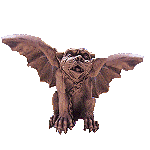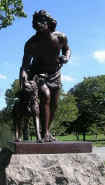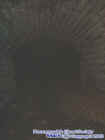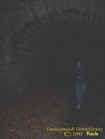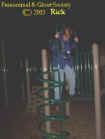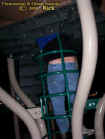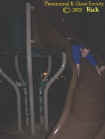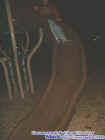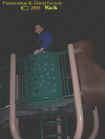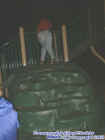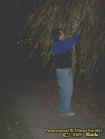|
|
||
|
It has been so many years since I visited Delaware Park till we decided to investigate this famous park in the Buffalo NY area. As a child I remember going sledding here. I almost fell through some ice on the pond and another time my ankle was ran over by a sled with steel blades. But I had many fond memories of my father when I was only 5 or 6 years old here some will last a life time. I even learned to ski here when grow up. The park is quite mysterious as Indian faces are carved into the bridge over Hyde Lake that are so real looking they seem as if they watch you. But one thing I always felt growing up is that the tunnel in the park was haunted. The thought slipped my mind till Liz and I were discussing it on our trip back from the Kinzua area. So hence the fact I decided to investigate and was very proud of our finds and results here. We wanted to focus on some main areas of the park such as the tunnel, one of the playgrounds, a wooded trail near the lake and a stone building on the edge of the park. These are areas with more activity and darker areas which are good places as far as looking for the supernatural goes. From our investigation here we found out the ghost are very playful many of them are children. We even played a little and still generated many ghost around us. Every area we visited in the park we got something on film. One of my first shots here was an apparitions so yes there are ghosts in this park. You would not think so because often when we see a pretty lake, jungle gyms, gardens nobody ever thinks that the unseen might be here as well. So that is what we wanted to bring to the WNY people is a story on this place to show that things are not always as they seem. They say that strange shadows are seen here and sometimes dogs act up in the park sometimes when people our out jogging or visiting the park. It is also said that before Delaware Park came to be it was a War Of 1812 base camp and that the winter was so awful here that many troops per day died of sickness, wounds, starvation and were buried in Forest Lawn Cemetery which is across the street from the park. Later however the soldiers were buried in Delaware Park probably where the rose garden is today. If you wanted to compare NYC central park to this one there is many similarities only Delaware Park is probably a little smaller but both are very old and you get all types of people from the city who come up here to enjoy a day jogging, picnicking, sledding Ect. It is funny that I just mentioned this because the designer of NYC central park also designed this park so it is no wonder why we have such similarities. I wanted to also do this investigation to tell others the do's and don'ts when visiting here. For anybody never go by yourself here at night sometimes not so nice people hang out just looking for trouble they will rob you or even physically harm you. The other thing is and PLEASE listen carefully over the last 30 years there have been many sexual assaults done to women here. I hear it on the news all the time I have even heard it through friends. There is a lot of places for anybody to hide in here and hurt a woman sexually or physically. So if you visit here because you want to take some ghostly photos or go jogging do it during the day. If you are good at capturing ghost you can do it day or night the wooden areas darken it enough to get good photos. I stress this because this is a nice park but with any place you visit there is always the dangers of mankind or mans evil intentions. The ghost here are very friendly and they care but they cannot save you from harmful people. So if you go always buddy up or take someone with you for safety reasons. In closing to this the question we ask is how did Delaware Park become haunted? Do the Soldiers from the War of 1812 haunt this park? Could it be unseen visitors from the cemetery across the street? Or could be the departed visiting to enjoy Shakespeare in the park near the rose garden since 1979? Or did something happen in the park more sinister such as murder? Drownings? You decide but one thing remains is that Delaware Park will always be watched by the departed as they play on the jungle Gym, Walk its trails, and even watch joggers from its dark tunnel. © By Rick-AngelOfThyNight |
||
|
|
||
|
Delaware Park A Little History Stanton M. Broderick The centerpiece of the Buffalo park system is Delaware Park, originally known simply as "The Park". 350 acres in size, it is one of the relatively few true parks Frederick Law Olmsted created; to Olmsted, only a very large, naturalistic site which would completely shield the visitor from the bustle and cares of the city could be considered a "park". It was also the first park for which Olmsted was given the opportunity to select the site to be used. In keeping with all of Olmsted's great parks, Delaware Park has three prime elements: a prominent water feature (the "Gala Water", now named "Hoyt Lake", of 42 acres formed by damming Scajaquada Creek), a large meadow of about 120 acres, and significant wooded areas. Located at what at the time was the outskirts of Buffalo, the park was crossed by only one city street. In a manner similar to his treatment of the traverse roads in New York's Central Park, he kept Delaware Avenue at a lower grade than much of the surrounding park, provided a viaduct to carry the park's carriage road above it, and shielded the park from it by thick plantings. Broad parkways connected this park with The Parade and The Front, the two smaller pleasure grounds of his original Buffalo design. |
||
|
|
|


